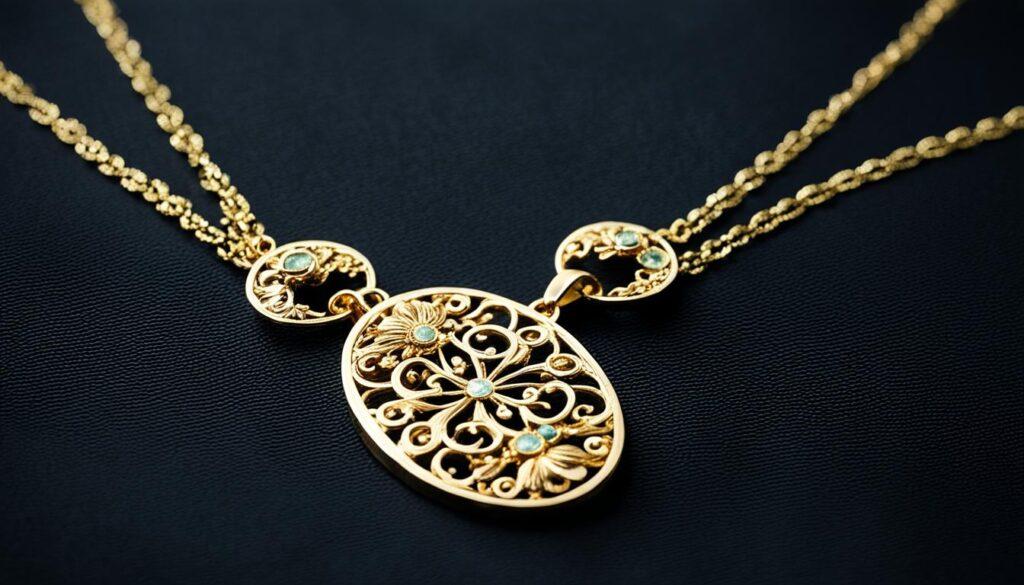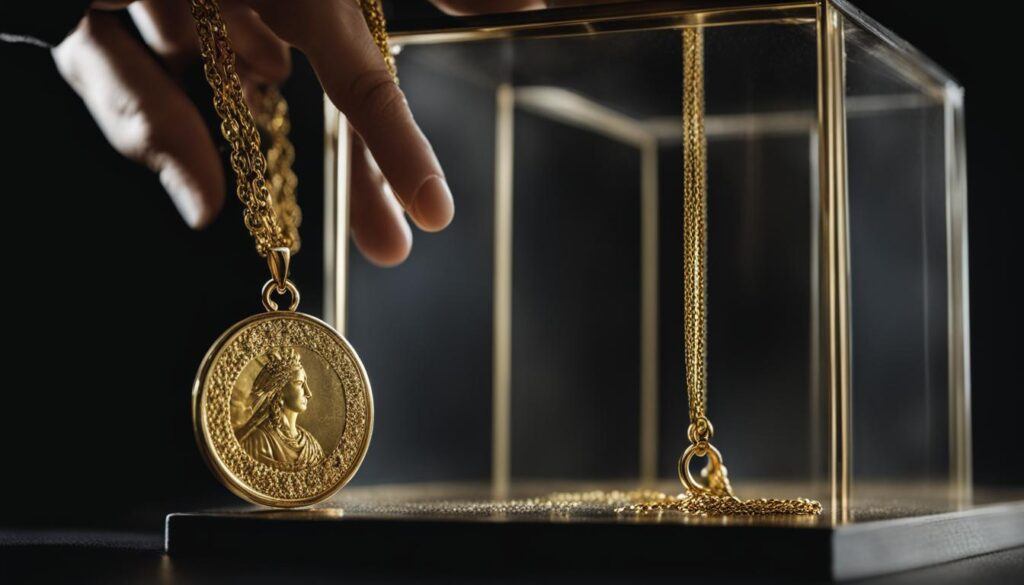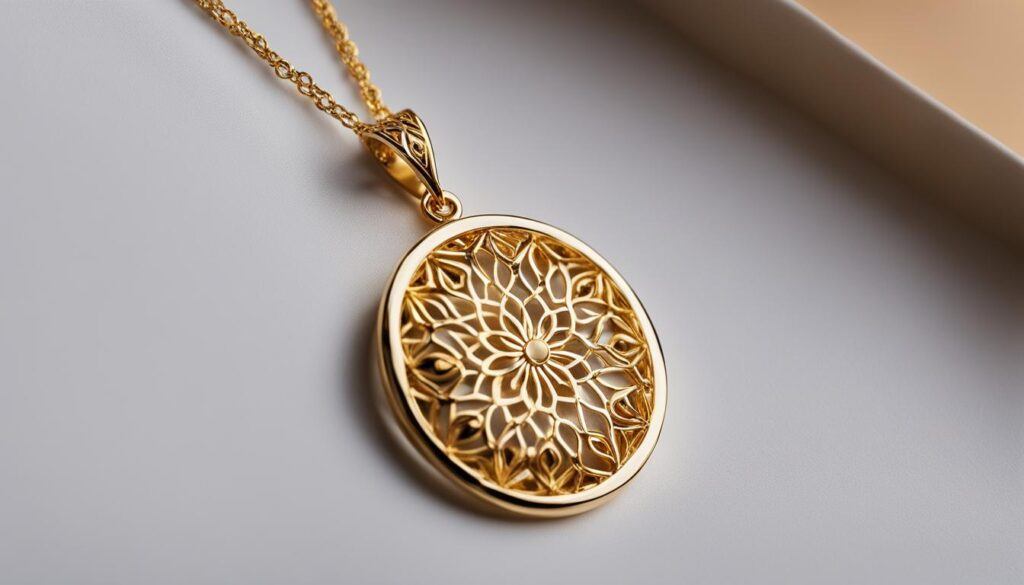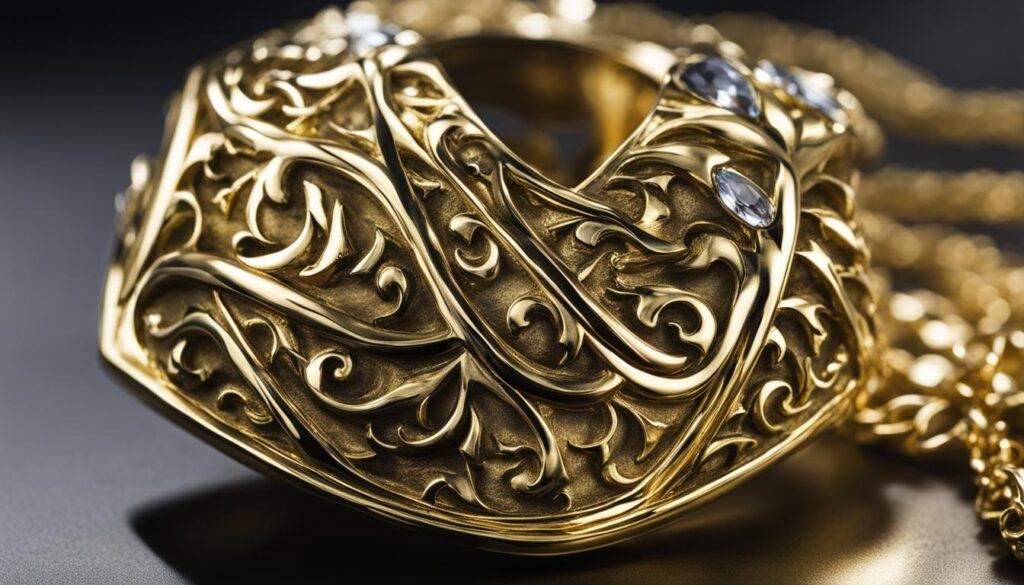Welcome to my article on gold plated sterling silver jewelry. If you’ve ever wondered whether gold plated sterling silver tarnishes, you’re in the right place! Gold-plated jewelry is a popular choice for its affordability and beautiful appearance. However, it’s crucial to understand how to care for and maintain gold-plated jewelry to keep it looking its best.
Key Takeaways:
- Gold-plated sterling silver jewelry can tarnish over time due to fading of the gold plating and exposure to external elements and chemicals.
- Proper care, such as regular cleaning and avoiding exposure to external elements and chemicals, can help prevent tarnish and maintain the luxurious look of gold-plated jewelry.
- Storing gold-plated jewelry in a pouch, case, or jewelry box can protect it from air and external elements.
- Avoid exposing gold-plated jewelry to showering, swimming, chlorine, saltwater, soapy water, and chemicals found in beauty products.
- Professional cleaning or re-plating may be necessary to restore the appearance of gold-plated jewelry in case of tarnishing.
What is Gold-Plated Sterling Silver Jewelry Made Of?
Gold-plated sterling silver jewelry is crafted using a combination of high-quality sterling silver and a thin layer of gold. The base metal, which can be sterling silver or brass, provides a sturdy foundation for the jewelry piece. The gold plating is applied to the surface of the base metal, creating a beautiful and luxurious finish.
The gold used in the plating process can be a gold alloy or fine gold. The use of alloys allows for different tones of gold, such as yellow gold, rose gold, or white gold. The fineness of the gold is determined by its carat measurement, with higher carat gold indicating a higher percentage of pure gold in the plating.
The thickness of the gold plating is measured in microns, with a thicker gold plating generally offering increased durability and longevity. The thicker the plating, the less likely it is to tarnish or wear off over time.
“Gold-plated sterling silver jewelry combines the elegance of gold with the affordability of silver, making it a popular choice among jewelry enthusiasts.”
Now that we understand the composition of gold-plated sterling silver jewelry, let’s explore why these pieces can tarnish over time and how to care for them properly.
Why Does Gold-Plated Sterling Silver Jewelry Tarnish?
Gold-plated sterling silver jewelry is a stunning accessory that adds elegance and style to any outfit. However, over time, you may notice that your beautiful gold-plated jewelry starts to lose its luster and tarnish. But why does this happen?
Tarnishing of gold-plated sterling silver jewelry occurs due to chemical reactions with pollutants and gases in the air. As the gold plating gradually fades, it exposes the underlying base metal, which is often sterling silver or brass. This exposure to air and environmental elements triggers a series of reactions that result in tarnishing.
Chemicals present in the air, such as sulfur, can react with the base metal and cause discoloration and tarnish on the surface of the jewelry. Additionally, pollutants in the environment, such as dust, dirt, and oils from our skin, can also contribute to the deterioration of the gold plating.
Proper care is essential to minimize tarnish and preserve the appearance of your gold-plated sterling silver jewelry. By following a few simple steps, you can extend the lifespan of your jewelry and keep it looking fabulous for years to come.
Proper Care Tips for Gold-Plated Sterling Silver Jewelry:
- Avoid exposing your jewelry to harsh chemicals, including household cleaning agents, perfumes, and hairsprays. These substances can accelerate tarnishing and cause damage to the gold plating.
- When not wearing your jewelry, store it in a clean, dry place away from direct sunlight. Consider using a jewelry box or a soft pouch to prevent exposure to air and external elements.
- Regularly clean your gold-plated jewelry using a soft cotton cloth. Gently wipe the surface to remove any dirt or oils that may have accumulated.
- Avoid using abrasive materials or harsh cleaning agents on your jewelry, as they can scratch or damage the gold plating. Stick to mild cleaning solutions, such as lukewarm water and a gentle dish soap.
- If your gold-plated jewelry requires deeper cleaning, you can soak it in a solution of lukewarm water and a small amount of dish soap. Gently scrub the jewelry with a soft toothbrush to remove any stubborn dirt or residue.
- Consider getting your gold-plated jewelry professionally cleaned and re-plated if you notice significant tarnishing or fading. Professional jewelers have the expertise and tools to restore the shine and luster of your jewelry.
By following these care tips and taking proper precautions, you can significantly reduce the risk of tarnish on your gold-plated sterling silver jewelry. Remember, prevention and regular maintenance are key to preserving the beauty and longevity of your cherished pieces.
| Causes of Tarnish | Preventive Measures |
|---|---|
| Chemical reactions with pollutants and gases in the air | Avoid exposing jewelry to harsh chemicals and pollutants |
| Exposure to sulfur and other chemicals in the environment | Store jewelry in a clean, dry place away from direct sunlight |
| Accumulation of dirt, dust, and oils from the skin | Regularly clean jewelry using a soft cotton cloth |
| Use of abrasive materials or harsh cleaning agents | Avoid using abrasive materials and stick to mild cleaning solutions |
| Significant tarnishing or fading | Consider professional cleaning and re-plating |

Tips for Cleaning Gold-Plated Silver Jewelry
When it comes to cleaning your beautiful gold-plated silver jewelry, it’s important to handle it with care to avoid damaging the delicate gold layer. Follow these tips to keep your jewelry looking radiant:
- Start by using a soft cotton cloth to gently wipe away any dirt or debris on the surface of your gold-plated silver jewelry. This will help to remove any buildup and restore its shine.
- For a more thorough cleaning, create a lukewarm soapy water bath by mixing a mild dish soap with water in a bowl. Avoid using harsh chemicals or gold/silver cleaning products, as they can strip away the gold plating.
- Place your gold-plated silver jewelry in the soapy water solution and let it soak for a few minutes. This will help to loosen any stubborn dirt or grime.
- After soaking, gently agitate the jewelry in the water to dislodge any remaining dirt particles. Avoid any vigorous scrubbing, as this can scratch the delicate gold plating.
- Rinse the jewelry thoroughly under lukewarm running water to remove any soap residue. Make sure to rinse all crevices and hard-to-reach areas to ensure a thorough clean.
- Once rinsed, carefully pat the jewelry dry using a clean, soft cloth. Avoid air-drying, as this can leave water spots on the surface.
- If you prefer, you can also seek professional cleaning services from a trusted jeweler. They have the necessary expertise and equipment to clean your gold-plated silver jewelry safely and effectively.
Remember, it’s important to avoid using rough or soiled cloths and to refrain from using gold or silver cleaning products, polishes, toothpaste, or any aggressive cleaning agents. These can damage the delicate gold plating and compromise the overall appearance of your jewelry.
Keeping your gold-plated silver jewelry clean and well-maintained will ensure its longevity and preserve its luxurious look for years to come.
Myth Dispel:
“Using toothpaste or baking soda can be effective for cleaning jewelry.” – This is a common misconception. While these household items may seem like quick cleaning solutions, they can be abrasive and cause damage to the delicate gold plating. Stick to gentle cleaning methods to protect your gold-plated silver jewelry.”
Preventing Tarnish on Gold-Plated Jewelry
To maintain the pristine appearance of your gold-plated jewelry, proper storage and care are essential. By following these tips, you can prevent tarnish and preserve the luxurious look of your gold-plated pieces for years to come.
Proper Storage
One of the most effective ways to prevent tarnish on gold-plated jewelry is to store it properly. When not wearing your jewelry, keep it in a soft pouch, a protective case, or a jewelry box. This will help shield it from exposure to air and external elements that can cause tarnishing.
Avoid Exposure to Chemicals
Chemicals found in everyday products such as perfumes, lotions, and cleaners can accelerate the tarnishing process. To avoid this, make sure to put on your gold-plated jewelry as the last step when getting ready and remove it first before using any chemicals. This will minimize exposure and help maintain its original shine.
Take Off Jewelry for Activities
Gold-plated jewelry is susceptible to damage from certain activities. It’s best to remove your jewelry before showering, swimming, or engaging in activities that involve exposure to chlorine, saltwater, or soapy water. This precaution will prevent harsh chemicals and external elements from tarnishing your jewelry.
Tip: By incorporating these habits into your routine, you can significantly prolong the lifespan of your gold-plated jewelry.
By following these preventive measures, you can keep your gold-plated jewelry looking its best. Proper storage, avoiding exposure to chemicals, and taking off your jewelry during certain activities will help maintain the integrity of the gold plating and prevent tarnish from dulling its allure.
Proper Care for Gold-Plated Sterling Silver
When it comes to gold-plated sterling silver jewelry, proper care is crucial for maintaining its beauty and longevity. Regular cleaning and wiping down are key practices in preserving the exquisite appearance of your gold-plated pieces. To ensure the best results, here are some essential tips to follow:
- Start by gently wiping down your gold-plated jewelry with a soft, non-abrasive cloth. This will remove any surface dirt or oils that may have accumulated.
- The natural oils in your skin act as a protective barrier against tarnish. Therefore, wearing your gold-plated jewelry regularly can actually help prevent tarnish buildup.
- For a deeper clean, you can create a simple solution using warm water and a mild dish soap. Avoid harsh detergents or abrasive cleaners, as they can damage the gold plating.
- Submerge your gold-plated jewelry in the warm soapy water and gently scrub it with a soft brush or cloth. This will remove any stubborn dirt or debris.
- Rinse your jewelry thoroughly under warm water to ensure that all the soap has been removed.
- After rinsing, carefully dry your jewelry with a clean, soft cloth or allow it to air dry. Avoid using heat to speed up the drying process, as it can cause the gold plating to peel or fade.
If your gold-plated jewelry requires professional cleaning or re-plating, it is best to consult a trusted jeweler who specializes in such services. They have the expertise and tools to restore the luster and shine of your jewelry effectively without causing any damage to the delicate gold plating. Professional cleaning and re-plating can help rejuvenate your gold-plated pieces, making them look as good as new.
Remember, by following these proper care practices, you can enjoy your gold-plated sterling silver jewelry for years to come, ensuring that it retains its luxurious allure and remains a cherished part of your collection.
Avoiding Exposure to External Elements
When it comes to maintaining the lustrous appearance of your gold-plated jewelry, avoiding exposure to external elements is crucial. By taking a few simple precautions, you can prevent damage and prolong the life of your precious pieces.
Showering, Swimming, and Water Exposure
To protect your gold-plated jewelry, it is important to avoid wearing it while showering, swimming, or engaging in any water activities. Exposure to chlorine, salt water, fresh water, and even soapy water can corrode the delicate gold plating, causing it to fade or tarnish over time.
Tip: Make gold-plated jewelry the last thing you put on and the first thing you take off. This way, you can avoid unnecessary exposure to water and protect its luxurious shine.
Avoiding Chemicals in Beauty Products
Chemicals commonly found in beauty products can also have a detrimental effect on gold-plated jewelry. Substances such as perfume, hairspray, makeup, and deodorants contain ingredients that can cause the gold plating to tarnish or discolor.
Tip: When using beauty products, it is best to apply them before putting on your gold-plated jewelry. This allows time for the products to absorb into your skin before wearing your jewelry, minimizing the risk of contact and potential damage.
Proper Storage and Care
To further protect your gold-plated jewelry, it is essential to store it properly when not in use. Consider storing your jewelry in a pouch, case, or jewelry box to shield it from exposure to air and external elements. This helps maintain its shine and minimize the risk of tarnish.
Tip: Store your gold-plated jewelry in a dark and cool place, away from humidity and heat, as these factors can accelerate the tarnishing process. Additionally, avoid placing your jewelry in contact with objects that can scratch or chip the delicate gold plating.
| External Elements to Avoid | Precautions |
|---|---|
| Water (showering, swimming, water activities) | Avoid wearing gold-plated jewelry during these activities to prevent exposure to chlorine, salt water, fresh water, and soapy water. |
| Chemicals in beauty products (perfume, hairspray, makeup, deodorants) | Apply beauty products before putting on your gold-plated jewelry to minimize contact and potential damage. |
| Improper storage and care | Store your gold-plated jewelry in a pouch, case, or jewelry box in a dark and cool place, away from humidity and heat. Avoid contact with objects that can scratch or chip the gold plating. |
By following these guidelines, you can ensure that your gold-plated jewelry stays beautiful and retains its luxurious shine for years to come.

Storing Gold-Plated Jewelry
Proper storage is crucial for maintaining the condition of your gold-plated jewelry. By taking the right measures, you can protect your precious pieces and extend their lifespan. Here are essential tips on storing gold-plated jewelry:
- Use a Pouch, Case, or Jewelry Box: Store your gold-plated jewelry in a dedicated pouch, case, or jewelry box. These options provide a safe and secure environment, protecting your pieces from exposure to air and external elements.
- Choose a Dark and Cool Place: Opt for a storage location that is away from direct sunlight and heat sources. A dark and cool place helps prevent excessive exposure to light and high temperatures, which can contribute to tarnishing.
- Avoid Humidity: Humidity can accelerate the tarnishing process of gold-plated jewelry. Store your pieces in a dry environment to minimize the risk of tarnish. Consider using silica gel packets in your storage area to absorb any excess moisture.
- Avoid Contact with Scratch-Causing Objects: To preserve the finish of your gold-plated jewelry, separate each piece or use individual compartments in your jewelry box. This prevents contact between the pieces and reduces the risk of scratches or chipping.
By following these storage practices, you can protect your gold-plated jewelry from unnecessary damage and maintain its luxurious appearance for years to come.
| Storage Tips for Gold-Plated Jewelry |
|---|
| Use a Pouch, Case, or Jewelry Box |
| Choose a Dark and Cool Place |
| Avoid Humidity |
| Avoid Contact with Scratch-Causing Objects |
Effects of External Elements on Gold-Plated Jewelry
Gold-plated jewelry can be susceptible to the effects of external elements and chemicals. Exposure to certain external factors can lead to discoloration, particularly when it comes to certain base metals like brass. High levels of humidity or exposure to saltwater can cause a reaction in the base metal, potentially breaking through the gold plating and impacting the overall appearance of the jewelry.

When gold-plated jewelry is exposed to high levels of humidity, the moisture in the air can cause the base metal to react. This reaction can result in discoloration, impacting the overall aesthetic of the jewelry piece.
In addition to humidity, saltwater can also have a detrimental effect on gold-plated jewelry. The salt in the water can accelerate the reaction between the base metal and the surrounding environment, which can lead to the deterioration of the gold plating.
“High levels of humidity and exposure to salt water can cause discoloration in gold-plated jewelry, as the base metal may react and break through the gold plating.”
To prevent damage to gold-plated jewelry, it is essential to consider these external elements and take necessary precautions. Avoiding prolonged exposure to high humidity levels and removing jewelry before activities involving saltwater can help preserve the quality and appearance of gold-plated jewelry.
Preventing Discoloration: Quick Tips
- Avoid wearing gold-plated jewelry in high humidity environments or during activities involving salt water.
- Remove gold-plated jewelry before showering, swimming, or participating in water-related sports.
- Wipe down jewelry after exposure to external elements to remove any residue.
- Store gold-plated jewelry in a cool, dry place to minimize the impact of humidity.
- Consider re-plating or refinishing gold-plated jewelry periodically to maintain its appearance.
Longevity of Gold-Plated Jewelry with Proper Care
With proper care, gold-plated jewelry can maintain its high quality for up to five years. By adopting the right practices, you can ensure that your gold-plated jewelry stays beautiful and lustrous for an extended period.
One of the fundamental aspects of maintaining the longevity of gold-plated jewelry is avoiding exposure to chemicals. Chemical substances found in beauty products, such as perfumes, lotions, cleaners, and even hairsprays, can negatively impact the appearance of your jewelry. It is recommended to make gold-plated jewelry the last thing you put on and the first thing you take off to minimize exposure to these substances.
Proper maintenance is another key factor in preserving the quality of your gold-plated jewelry. Regular cleaning is essential to remove dirt and prevent tarnish. Wiping down your jewelry with a soft, non-abrasive cloth on a regular basis can help maintain its shine. The natural oils in your skin can also act as a protective barrier against tarnish, so wearing your gold-plated jewelry often can actually help enhance its longevity.
In case your gold-plated jewelry does tarnish, there are ways to fix it and restore its original luster. Gently cleaning the jewelry with a mixture of lukewarm water and mild dish soap can help remove tarnish. Avoid using rough or abrasive materials that can scratch the surface. After a thorough cleaning, rinse the jewelry under running water and wipe it dry with a soft cloth. This process can help remove light tarnish and restore the shine to your gold-plated jewelry.
For more severe tarnishing or if the gold plating has worn off in certain areas, re-plating may be necessary. Re-plating involves adding a fresh layer of gold onto the jewelry, restoring its original beauty. It is recommended to have re-plating done by a professional jeweler to ensure proper application and a long-lasting result.
Benefits of Proper Care for Gold-Plated Jewelry
By following the proper care techniques, you can enjoy several benefits with your gold-plated jewelry:
- Extended lifespan: With up to five years of proper care, your gold-plated jewelry can continue to look stunning and maintain its luxurious appeal.
- Cost-effectiveness: By preserving the longevity of your jewelry, you can avoid the need for frequent replacements, saving you money in the long run.
- Preservation of sentimental value: Proper care ensures that your gold-plated jewelry remains in excellent condition, allowing you to pass it down as a treasured heirloom or hold onto it as a special keepsake.
| Benefits of Proper Care | Description |
|---|---|
| Extended lifespan | With up to five years of proper care, your gold-plated jewelry can continue to look stunning and maintain its luxurious appeal. |
| Cost-effectiveness | By preserving the longevity of your jewelry, you can avoid the need for frequent replacements, saving you money in the long run. |
| Preservation of sentimental value | Proper care ensures that your gold-plated jewelry remains in excellent condition, allowing you to pass it down as a treasured heirloom or hold onto it as a special keepsake. |
By implementing the right care routine and avoiding exposure to harmful elements, you can ensure that your gold-plated jewelry maintains its beauty and elegance for years to come.
Recommended Brands and Tips for Gold-Plated Jewelry
When it comes to gold-plated jewelry, different brands offer a variety of options to choose from. To ensure the longevity and maintenance of your gold-plated pieces, it is essential to follow the specific care instructions provided by the brand. Here are some tips to help you take care of your precious gold-plated jewelry:
- Regular Cleaning: Clean your gold-plated jewelry regularly to remove dirt, oils, and other residues that can dull its shine. Use a soft cotton cloth to gently wipe the surface, ensuring that you avoid any harsh detergents or abrasive materials.
- Proper Storage: Store your gold-plated jewelry in a pouch, case, or jewelry box to protect it from exposure to air and external elements. This will help prevent tarnish and keep your pieces looking beautiful for longer.
- Avoid Harsh Chemicals: Avoid exposing your gold-plated jewelry to harsh chemicals found in cleaning products, perfumes, lotions, and other beauty products. These chemicals can accelerate the tarnishing process and damage the plating.
- Professional Cleaning and Re-Plating: Depending on the brand and the quality of the gold plating, some recommend professional cleaning or re-plating services to restore the appearance of your gold-plated jewelry. Consult the brand’s guidelines or visit a trusted jeweler who specializes in gold-plated jewelry.
By following these tips and recommendations, you can ensure that your gold-plated jewelry retains its luster and remains a cherished accessory for years to come.
Recommended Brands:
| Brand | Description |
|---|---|
| Tiffany & Co. | Tiffany & Co. offers a range of exquisite gold-plated jewelry crafted with attention to detail and quality. Their pieces are designed to stand the test of time and come with care instructions to maintain their beauty. |
| Pandora | Pandora is known for its iconic gold-plated charm bracelets and other jewelry pieces. With their commitment to craftsmanship, Pandora provides care tips to keep your gold-plated jewelry looking as good as new. |
| Michael Kors | Michael Kors offers a collection of luxurious gold-plated jewelry that adds a touch of elegance to any outfit. Their care instructions guide you on how to preserve the beauty and shine of their gold-plated pieces. |

“Taking proper care of your gold-plated jewelry is essential to maintain its beauty and prolong its lifespan. Following the care instructions provided by the brand and implementing these tips can help you enjoy your gold-plated pieces for years to come.” – Me
Conclusion
Gold-plated sterling silver jewelry is a stunning accessory that can add a touch of elegance to any outfit. However, it is important to remember that the gold plating can fade over time, leading to tarnishing of the jewelry. Exposure to external elements and chemicals can also contribute to this tarnishing process.
Fortunately, by following a few simple care tips, you can prevent tarnish and maintain the luxurious look of your gold-plated jewelry for a longer period. Regular cleaning with a soft, non-abrasive cloth can help remove dirt and keep the jewelry looking its best. Avoiding exposure to external elements, such as chlorine, saltwater, and soapy water, is crucial to prevent damage to the gold plating.
Proper storage is another important aspect of caring for gold-plated jewelry. Storing it in a pouch, case, or jewelry box can protect it from air exposure and external factors. It is also recommended to keep the jewelry in a cool, dry place, away from humidity and heat.
In case your gold-plated jewelry does experience tarnishing, professional cleaning or re-plating services can help restore its original shine. With proper care and maintenance, you can enjoy the beauty and elegance of your gold-plated sterling silver jewelry for years to come.
FAQ
Does Gold Plated Sterling Silver Tarnish?
Gold-plated sterling silver jewelry can tarnish over time due to the fading of the gold plating and exposure to external elements and chemicals. However, by following proper care tips, such as regular cleaning, avoiding exposure to external elements, and proper storage, one can prevent tarnish and maintain the luxurious look of gold-plated jewelry for a longer period. In case of tarnishing, professional cleaning or re-plating can help restore the jewelry to its original shine.
What is Gold-Plated Sterling Silver Jewelry Made Of?
Gold-plated sterling silver jewelry is made by covering a base metal, such as sterling silver or brass, with a thin layer of gold. The surface can be a gold alloy or fine gold, with different carat measurements indicating the fineness of the gold. The color of the alloys can vary, and the thickness of the gold plating is measured in microns.
Why Does Gold-Plated Sterling Silver Jewelry Tarnish?
Gold-plated sterling silver jewelry may tarnish due to chemical reactions with pollutants or gases in the air. Over time, the gold plating can fade, exposing the base metal and leading to tarnishing. Proper care is crucial to minimize tarnish and maintain the appearance of the jewelry.
Tips for Cleaning Gold-Plated Silver Jewelry
Gold-plated silver jewelry can be cleaned with a soft cotton cloth to remove dirt and polish the surface. For a more thorough cleaning, a lukewarm soapy water bath can be used, followed by rinsing and careful drying. It is important to avoid using rough or soiled cloths and to refrain from using gold or silver cleaning products, polishes, toothpaste, or aggressive cleaning agents. Professional jewelers can also provide professional cleaning services.
Preventing Tarnish on Gold-Plated Jewelry
To prevent tarnish on gold-plated jewelry, proper storage is essential. Storing jewelry in a pouch, case, or jewelry box can help protect it from exposure to air and external elements. It is important to avoid exposing gold-plated jewelry to chemicals found in perfumes, lotions, cleaners, and other beauty products. Taking off jewelry before showering, swimming, or engaging in activities that may expose it to chlorine, saltwater, or soapy water can also help prevent tarnish.
Proper Care for Gold-Plated Sterling Silver
Proper care for gold-plated sterling silver jewelry includes regular cleaning and wiping down with a soft, non-abrasive cloth. The oils in the skin can help prevent tarnish build-up on silver. For a deeper clean, a mixture of warm water and dish soap can be used, followed by rinsing and wiping dry. If necessary, professional cleaning or re-plating can restore the appearance of the jewelry.
Avoiding Exposure to External Elements
To prevent damage to gold-plated jewelry, it is important to avoid exposing it to showering, swimming, and other activities that may involve chlorine, salt water, fresh water, or soapy water. Chemicals present in beauty products, such as perfume, hairspray, makeup, and deodorants, can also affect the appearance of gold-plated jewelry. It is recommended to make gold-plated jewelry the last thing you put on and the first thing you take off to minimize exposure to these substances.
Storing Gold-Plated Jewelry
Proper storage is important for maintaining the condition of gold-plated jewelry. Storing jewelry in a pouch, case, or jewelry box can protect it from exposure to air and external elements. It is advisable to store jewelry in a dark, cool, and dry place to avoid humidity and heat, which can contribute to tarnish. Separating pieces to avoid contact with objects that can scratch or chip the finish is also recommended.
Effects of External Elements on Gold-Plated Jewelry
Gold-plated jewelry can be affected by exposure to external elements and chemicals. Certain base metals, such as brass, can cause discoloration when exposed to high levels of humidity or salt water. The base metal may react and break through the gold plating, affecting the appearance of the jewelry.
Longevity of Gold-Plated Jewelry with Proper Care
With proper care, gold-plated jewelry can maintain its high quality for up to five years. Avoiding exposure to chemicals, proper maintenance, and regular cleaning can help prolong the longevity of the jewelry. In case of tarnishing, it is possible to fix it through cleaning or re-plating.
Recommended Brands and Tips for Gold-Plated Jewelry
Different brands offer gold-plated jewelry, and it is recommended to follow their specific care instructions. Some brands may recommend professional cleaning or re-plating services for maintaining the appearance of gold-plated jewelry.



